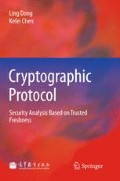Abstract
Four security definitions about unilateral authentication secure, mutual authentication secure, unilateral session key secure, or mutual session key secure are given respectively under the computational model of matching conversation and indistinguishability. An informal analysis approach based on trusted freshness is presented, and the analysis results suggest the correctness of a protocol or the way to construct attacks intuitively from the absence of security properties. Then, the reasons why typical attacks on authentication protocols exist are discussed based on trusted freshness, and corresponding examples are illustrated to corroborate the discussion.
Access this chapter
Tax calculation will be finalised at checkout
Purchases are for personal use only
Preview
Unable to display preview. Download preview PDF.
References
Needham RM, Schroeder MD (1978) Using Encryption for Authentication in Large Network of Computers. Communication of the ACM 21(12): 993–999
Feige U, Fiat A, Shamir A (1987) Zero Knowledge Proofs of Identify. In: STOC’87 Proceedings of the Nineteenth Annual ACM Symposium on Theory of Computing, New York, 25–27 May 1987
Miller SP, Neuman BC, Schiller JI, Saltzer JH (1987) Kerberos Authentication and Authorization System. Paper Presented at the Project Athena Technical Plan Section E.2.1. MIT, Boston
CCITT (1987) CCITT Draft Recommendation X.509. The Directory-Authentication Framework (Version 7), New York
Woo TYC, Lam SS (1992) Authentication for Distributed Systems. Computer 25(1): 39–52
Kaufman C (1993) Distributed Authentication Security Service, RFC 1507. http://www.ietf.org/rfc/rfc1507.txt. Accessed 7 Sept 2010
Okamoto T (1993) Provably Secure and Practical Identification Schemes and Corresponding Signature Scheme. In: CRYPTO’92 Proceedings of the 12th Annual International Cryptology Conference on Advances in Cryptology, Santa Barbara 16–20 Aug 1992. Lecture Notes in Computer Science, vol 740, pp 31–53, Springer
IBM Zurich Laboratory (1995) Internet Keyed Payments Protocol (IKP). http://www.zurich.ibm.com /Technology/Security/extern/ecommerce/spec. Accessed 30 June 2010
Lowe G (1995) An Attack on the Needham-Schroeder Public-key Authentication Protocol. Information Processing Letters 56(3): 131–133
Abadi M, Needham R (1996) Prudent Engineering Practice for Cryptographic Protocols. IEEE Transactions on Software Engineering 22(1): 6–15
Freier AO, Karlton P, Kocher PC (1996) The SSL Protocol Version 3.0. http://wp.netscape.com/eng/ssl3/draft302.txt. Accessed 18 Nov 1996
Clark J and Jacob J (1997) A Survey of Authentication Protocol Literature: Version 1.0. http://www.win.tue.nl/≈ecss/downloads/clarkjacob.pdf. Accessed Nov 2010
SET. Secure Electronic Transaction. The SET Standard Specification. http:// www.setco.org/set-specifications. Accessed May 1997
Harkins D, Carrel D (1998) The Internet Key Exchange Protocol (IKE), RFC 2409. http://www.ietf.org/rfc/rfc2409.txt. Accessed 12 Dec 2010
ANSI/IEEE Std 802.11. Wireless LAN Medium Access Control (MAC) and Physical Layer (PHY) Specifications. Sept 1999
Burrows M, Abadi M, Needham R (1990) A Logic of Authentication. ACM Transactions on Computer Systems 8(1): 18–36
Bellare M, Rogaway P (1993) Entity Authentication and Key Distribution. In: CRYPTO’93 Proceedings of the 13th Annual International Cryptology Conference on Advances in Cryptology, Santa Barbara, 22–26 Aug 1993. Lecture Notes in Computer Science, vol 773, pp 232–249, Springer
Lowe G (1999) Towards a Completeness Result for Model Checking of Security Protocols. Journal of Computer Security 7(2–3): 89–146
Canetti R, Krawczy H (2001) Analysis of Key-exchange Protocols and Their Use for Building Secure Channels. In: EUROCRYPT’01 Proceedings of the International Conference on the Theory and Application of Cryptographic Techniques: Advances in Cryptology, Innsbruck, 6–10 May 2001. Lecture Notes in Computer Science, vol 2045, pp 453–474, Springer
Blanchet B (2006) A Computationally Sound Mechanized Prover for Security Protocols. In: Proceedings of the 2006 IEEE Symposium on Security and Privacy, Berkeley/Oakland, 21–24 May 2006
Datta A, Derek A, Mitchell JC, Roy A (2007) Protocol Composition Logic (PCL). Electronic Notes in Theoretical Computer Science 172: 311–358.
Mao W (2004) Modern Cryptography: Theory and Practice. Prentice Hall, New Jersey
Dolev D, Yao AC (1983) On the Security of Public Key Protocols. IEEE Transactions on Information Theory 29(2): 198–208
Bellare M, Rogaway P (1993) Random Oracles are Practical: a Paradigm for Designing Efficient Protocols. In: CCS’93 Proceedings of the 1st ACM Conference on Computer and Communications Security, Fairfax, 3–5 Nov 1993
Goldwasser S, Micali S (1984) Probabilistic Encryption. Journal of Computer and System Sciences 28(2): 270–299
Dong L, Chen K, Zheng Y, Hong X (2008) The Guarantee of Authentication Protocol Security. Journal of Shanghai JiaoTong University 42(4): 518–522
Otway D, Rees O (1987) Efficient and Timely Mutual Authentication. Operating Systems Review 21(1): 8–10
Diffie W, Hellman ME (1976) New Directions in Cryptography. IEEE Transactions on Information Theory 22(6): 644–654.
Menezes A, van Oorschot P, Vanstone S (1996) Handbook of Applied Cryptography. CRC Press, New York
Matsumoto T, Takashima Y, Imai H (1986) On Seeking Smart Public-key Distribution Systems. Trans. IECE Japan 69(2): 99–106.
Denning DE, Sacco GM (1981) Timestamps in Key Distribution Protocols. Communication of the ACM 24(8): 533–536
Woo TYC, Lam SS (1994) A Lesson on Authentication Protocol Design. ACM Operating Systems Review 28(3): 24–37
Neuman BC, Stubblebine SG (1993) A Note on the Use of Timestamps as Nonces. Operating Systems Review 27(2): 10–14
Bird R, Gopal I, Herzberg A, Janson P, Kutten S, Molva R, Yung M (1995) The KryptoKnight Family of Light-weight Protocols for Authentication and Key Distribution. IEEE/ACM Transactions on Networking 3(1): 31–41
Tatebayashi M, Matsuzaki N, Newman D (1989) Key Distribution Protocol for Digital Mobile Communication Systems. In: CRYPTO’93 Proceedings of the 9th Annual International Cryptology Conference on Advances in Cryptology, Santa Barbara, 20–24 Aug 1989. Lecture Notes in Computer Science, vol 435, pp 324–334, Springer
Lowe G, Roscoe B (1997) Using CSP to Detect Errors in the TMN Protocol. IEEE Transactions on Software Engineering 23(10): 659–669
Tanenbaum AS (2001) Computer Networks, 3rd edn. Prentice Hall, New Jersey
Zhou J, Gollmann D (1996) A Fair Non-repudiation Protocol. In: Proceedings of 1996 IEEE Symposium on Security and Privacy, Oakland, 6–8 May 1996
Zhou J (1996) Non-repudiation. PhD Dissertation, University of London
Author information
Authors and Affiliations
Rights and permissions
Copyright information
© 2012 Higher Education Press, Beijing and Springer-Verlag Berlin Heidelberg
About this chapter
Cite this chapter
Dong, L., Chen, K. (2012). Informal Analysis Schemes of Cryptographic Protocols. In: Cryptographic Protocol. Springer, Berlin, Heidelberg. https://doi.org/10.1007/978-3-642-24073-7_4
Download citation
DOI: https://doi.org/10.1007/978-3-642-24073-7_4
Publisher Name: Springer, Berlin, Heidelberg
Print ISBN: 978-3-642-24072-0
Online ISBN: 978-3-642-24073-7
eBook Packages: Computer ScienceComputer Science (R0)

